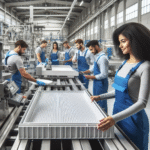FRP (fiberglass reinforced plastic) grating is one of the most adaptable products in use today, a vast array of industrial and infrastructure projects relies on them for their superior strength, corrosion resistance and safety features. Inside factories, manufacturing plants and assembly lines, the usage of a FRP grating as a walking surface or platform can help to withstand heavy foot traffic and harsher operating conditions. FRP grating is also resistant to corrosive chemicals, making them ideally suited for chemical processing and in wastewater treatment facilities. FRP grating can also tolerate moisture and saltwater exposure – making it a prime candidate for offshore platforms and marine docks. FRP gratings are also extensively used in cooling towers and electrical substations because they are non-conductive, lightweight and durable. In food processing units, FRP gratings offer a hygienic, slip-resistant walking surface with easy-to-clean characteristics. Public infrastructure projects make use of FRP pedestrian bridges, drainage covers and pedestrian access areas due to their durability. Available in custom sizes and designs, FRP gratings are a long-lasting, low-maintenance products, that offer long-term value across many different applications.
How Fiberglass Gratings manufacturers assure quality control?
Fiberglass grating manufacturers implement quality control in various ways, including controlled manufacturing processes, auditable testing methods, and accepted international standards. From selecting the raw materials such as high-grade resins and fiberglass roving to precision-controlled pultrusion and melded processes, trained quality control teams monitor every step in the process. Manufacturers perform extensive in-house testing, including load-bearing capacity, fire compliance, chemical resistance, and product dimension verification, to ensure consistency and reliability of products. Many manufacturers have ISO certified quality management systems, and ensure that every FRP grating delivered is durable, safe, and performance-ready in industrial environments.
Technological Trends that every Fiberglass Gratings manufacturers must adopt in modern times
In today’s competitive and safety-conscious industrial arena, a fiberglass gratings manufacturer must adopt modern technology trends so they can remain competitive. They should recognize applied automated pultrusion systems and precision compression molding for reliable cycles and quality standards. In larger orders or complex parts, the use of CAD and 3D modelling software leads to advanced solutions to project requirements at a higher accuracy. The addition of smart curing systems with real-time digital monitoring greatly improves efficiency. In addition, enterprises have to consider energy that is consumed in the process, allowing products to be produced with less material waste. Enterprises are now benefiting from the IoT controlled tracking and quality monitoring systems too; making products easier to trace, control inventory, and notify defects. At face value, these products create enhanced productivity, but in many cases are well beyond expectations for: increased reliability, safety and are potentially good for international competition.
Conclusion
With industry diversification and demand for safer, longer-lasting, and low-maintenance solutions, fiberglass gratings offer a broad range of applications and are rapidly becoming the preferred product in many situations. Fiberglass gratings are utilized for a wide variety of industrial, marine, and public works projects. They provide unquestionable versatility and performance as part of a grating solution. Modern grating manufacturers are establishing the new standard in safety, reliability, and efficiency through manufacturing process quality control, technological advancements such as enhanced automated manufacturing, CAD-controlled individual solutions or customization, and remote access and monitoring with IoT capability. FRP gratings have successfully supported numerous specifications and built environments, performance, and durability designed for harsh environments and limitless solution opportunities, ensuring fiberglass grating’s position as an essential component of intriguing future consideration as part of industrial flooring and structural support systems.









